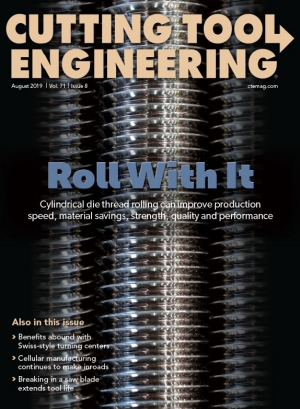The past century certainly has seen a variety of developments with turning. Some, including new substrates and chipbreakers, have fine-tuned the process, making it more effective. But overall, turning has remained basically the same. Even indexable inserts used for contouring are set at fixed angles. The inserts have remained static.
Ceratizit SA, Mamer, Luxembourg, hopes to change the turning process altogether with High Dynamic Turning and FreeTurn tools.
The goal is to move from static positioning of the spindle and inserts to a more dynamic position that allows a full range of motion, said Lothar Schmid, innovation manager at Ceratizit’s Innovation Center in Reutte, Austria.
“HDT is the machining concept that uses FreeTurn tools in application,” he said.

HDT and FreeTurn tooling will enable users to conduct roughing, finishing, contour turning, face turning and longitudinal turning with a single tool. Image courtesy of Ceratizit
Central to HDT is the idea that the spindle essentially can have 360° of freedom. Ceratizit states that this flexibility comes without risk of collision. Also, the approach, or lead, angle can be adjusted during cutting, an especially useful feature when contouring.
The tool body is stable when combining its slender shank and the rotational freedom. The FreeTurn insert attaches by screw and has multiple cutting edges with different properties, including various angles, corner radii and chipbreakers.
The combination of motion and multiple edges means that the FreeTurn tool can cut above and below a piece without having to reposition or change the insert.
“Companies that use HDT with FreeTurn tools will benefit in many ways,” Schmid said. “They will save considerable time changing tools. They’ll save time by having fewer tool changes, less air cuts and higher cutting data with different approach angles. Our customers will also enjoy longer tool life due to the more efficient use of the whole cutting edge. Reduced vibrations can also provide an advantage, and there will also be fewer number of places needed in the tool magazines.”
As the technology and tools develop, machinists will be able to work with the inserts based on job requirements, including different coatings and cutting materials.
To apply FreeTurn tools, a machine needs X, Y and Z linear axes and B and C rotation axes. So far, the technology is compatible for programming with FANUC, Mazatrol and Siemens Sinumerik 840D software.
“We will have a starting standard program of tools at EMO 2019,” Schmid said. “But of course the high flexibility in the FreeTurn tools and inserts allows lots of customized possibilities in cooperation with our customers.”
For more information about Ceratizit USA Inc., Warren, Michigan, call 800-783-2280 or visit www.ceratizit.com.
Contact Details
Related Glossary Terms
- lead angle
lead angle
Angle between the side-cutting edge and the projected side of the tool shank or holder, which leads the cutting tool into the workpiece.
- shank
shank
Main body of a tool; the portion of a drill or similar end-held tool that fits into a collet, chuck or similar mounting device.
- turning
turning
Workpiece is held in a chuck, mounted on a face plate or secured between centers and rotated while a cutting tool, normally a single-point tool, is fed into it along its periphery or across its end or face. Takes the form of straight turning (cutting along the periphery of the workpiece); taper turning (creating a taper); step turning (turning different-size diameters on the same work); chamfering (beveling an edge or shoulder); facing (cutting on an end); turning threads (usually external but can be internal); roughing (high-volume metal removal); and finishing (final light cuts). Performed on lathes, turning centers, chucking machines, automatic screw machines and similar machines.









